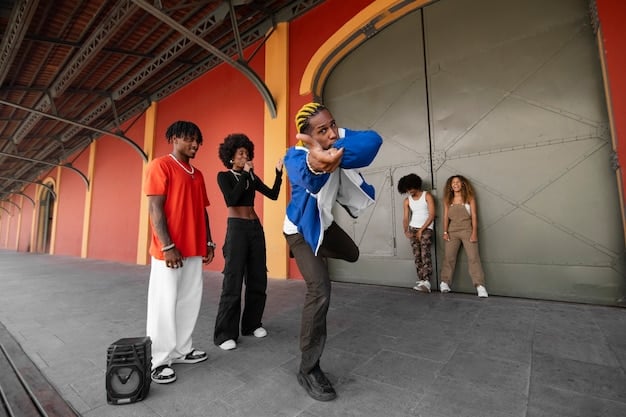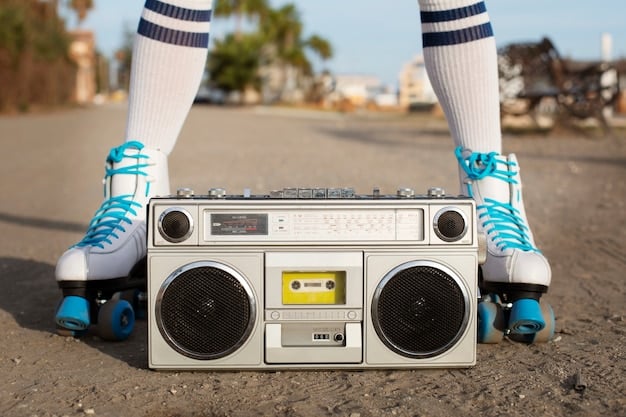Underground Rap Radio: How It Evolves on Airwaves & Digital Platforms

Underground rap radio is adapting to the changing music landscape by leveraging digital platforms while maintaining its core identity and discovering new talent.
The world of hip-hop has seen profound changes, and one of the most vibrant areas is the realm of underground rap radio. Underground rap radio has historically championed independent artists and fostered a unique culture around the music, but the rise of digital platforms has dramatically changed the industry forever. This article will cover how Underground Rap Radio is adapting and evolving in the changing landscape of digital platforms and airwaves.
The Historical Significance of Underground Rap Radio
Underground rap radio’s history traces back to the late 1970s and early 1980s. They acted as a vital outlet for artists who couldn’t find support from commercial stations. These stations played a crucial role in building the careers of many hip-hop legends by providing opportunities for them to be heard and gain recognition.
The Pioneers of Underground Rap Radio
Several pioneering stations and DJs laid the groundwork for the underground rap scene. These included individuals who saw the potential in hip-hop early on and were willing to take risks by supporting it on the airwaves.
The Impact on Hip-Hop Culture
Underground rap radio significantly impacted the broader hip-hop culture. It created communities, promoted artistic expression, and empowered marginalized voices. The stations often featured local artists and fostered talent, becoming hubs for creativity and innovation.

- Community Building: These stations provided a space for fans and artists to connect, share ideas, and build relationships.
- Artistic Development: Underground radio allowed artists to experiment with new sounds and styles, pushing the boundaries of the genre.
- Voice for the Marginalized: By giving airtime to independent and minority artists, these stations helped amplify voices and perspectives often ignored by mainstream media.
Underground rap radio’s historical roots are deeply embedded in the rise and evolution of hip-hop. It established the groundwork for the independent hip-hop movement, helping to shape the careers of countless artists and cultivating a thriving cultural scene celebrated today.
The Shift to Digital Platforms
The digital revolution has profoundly changed how music is created, distributed, and consumed. Streaming services, social media, and online radio stations have created new opportunities and challenges for underground rap radio.
The Rise of Streaming Services
Streaming services have changed the music distribution landscape, making it easier for artists to reach listeners worldwide. Platforms like Spotify, Apple Music, and SoundCloud offer independent artists tools to upload their music and connect with fans directly.
The Impact of Social Media
Social media platforms like Twitter, Instagram, and TikTok have become vital tools for underground rap artists to build their brands, engage with fans, and promote their music. Visual content, short clips, and interactive sessions have enabled artists to create personal connections with their audience.

Online Radio and Podcasts
Online radio stations and podcasts dedicated to underground rap have emerged as powerful platforms for showcasing new talent and connecting with niche audiences. These stations often feature curated playlists, interviews, and live performances, offering a unique listening experience.
Underground rap radio’s shift to digital platforms has been transformative, opening up new avenues for artists to connect with audiences and promote their music. While these platforms offer unprecedented reach and opportunities, they also pose challenges that must be addressed.
Challenges and Opportunities in the Digital Age
While digital platforms offer many advantages, they also come with challenges. Discoverability, monetization, and maintaining authenticity are pivotal obstacles for underground rap radio in the digital era.
Discoverability and Saturation
With millions of songs available on streaming services, breaking through the noise and getting discovered can be daunting. Algorithms and curated playlists often favor established artists, making it difficult for new talent to gain visibility.
Monetization Strategies
Monetizing music in the digital age is another challenge. Streaming royalties are meager, and artists must find creative ways to generate revenue through merchandise, live performances, and direct fan support.
- Direct Fan Support: Platforms like Patreon, Bandcamp, and Kickstarter enable fans to directly support their favorite artists, fostering a sense of community and sustainability.
- Merchandise Sales: Selling merchandise such as t-shirts, vinyl records, and limited-edition items can generate revenue and strengthen the connection between artists and their fanbase.
- Licensing and Sync Deals: Getting music placed in films, TV shows, and commercials generates income and exposes artists to a wider audience.
Maintaining Authenticity and Independence
In the digital age, maintaining authenticity and independence is essential for underground rap artists. The pressure to conform to mainstream trends can compromise the unique artistic vision that defines the genre.
The digital age presents both challenges and opportunities for underground rap radio. Overcoming these obstacles requires innovative strategies, creativity, and a commitment to preserving the essence of the scene.
Strategies for Navigating the Changing Landscape
Adapting to the changing landscape requires underground rap radio stations and artists to adopt new strategies. Collaboration, niche marketing, and community engagement are key for longevity and success.
Collaboration and Networking
Collaborating with other artists, DJs, and industry professionals can expand reach and create new opportunities. Networking at events, online forums, and social media groups foster relationships and cross-promotion.
Niche Marketing and Audience Segmentation
Identifying and targeting niche audiences can increase engagement and loyalty. Creating content tailored to specific demographics, interests, and sub-genres can help artists connect with fans.
Community Engagement and Fan Interaction
Building a strong relationship with fans can be achieved through active community engagement and interaction via social media, live streams, and Q&A sessions. Responding to comments, taking requests, and involving fans in the creative process builds loyalty and support.
Navigating the evolving landscape requires adaptability, creativity, and a commitment to building genuine connections with fans. Underground rap radio stations and artists who embrace these strategies will be able to thrive in the digital age.
The Role of Radio in the Digital Era
Despite the rise of digital platforms, radio still serves an important purpose. Blending old and new methods, focusing on local content, and curating unique listening experiences can help radio maintain its relevance.
Blending Traditional and Digital Approaches
Radio stations can enhance their reach by integrating digital platforms into their operations. Digital platforms can be integrated by live-streaming shows, creating podcasts, and using social media to engage with listeners in real-time.
Focus on Local Content and Community
Highlighting local artists, covering community events, and supporting neighborhood initiatives makes the station a valuable resource for residents.
- Local Artist Showcases: Featuring local artists’ music, interviews, and live performances introduces talent to the community.
- Community Event Coverage: Broadcasting local events, festivals, and concerts fosters community spirit and support.
- Supporting Local Initiatives: Partnering with local businesses, charities, and organizations helps address community needs and strengthen ties.
Curating a Unique Listening Experience
Creating themed shows, hosting special guests, and offering exclusive content can provide a unique listening experience that differentiates the station from streaming services. Stations like Rinse FM are known for their contributions to drum and bass, grime, and other genres that are constantly growing in popularity.
The role of radio in the digital era revolves around blending traditional and digital approaches, concentrating on local content, and curating unique listening experiences. By embracing these strategies, radio can remain a critical part of the music ecosystem.
Future Trends and Predictions
Looking forward, several trends and predictions can shape the future of underground rap radio. AI, virtual reality, and the Metaverse are expected to play a significant role.
The Influence of AI and Algorithms
AI-powered music discovery tools can help listeners find new artists and songs that match their tastes. Algorithms can also automate tasks such as programming, content creation, and ad targeting.
Virtual Reality and the Metaverse
VR and the Metaverse offer new ways for artists to engage with fans in immersive, interactive environments. Virtual concerts, meet-and-greets, and listening parties can happen in these digital spaces.
The Continued Importance of Curation and Human Connection
Despite technological advancements, curation and human connection remain essential in the music experience. DJs and radio hosts play a vital role in introducing new music, sharing stories, and fostering community through their selections and commentary.
The future of underground rap radio is expected to be shaped by a blend of technological innovations and traditional values. Embracing these trends while maintaining a strong connection to the creative process will equip the genre as a whole to thrive in an ever-evolving landscape.
| Key Point | Brief Description |
|---|---|
| 🎤 Historical Roots | Underground rap radio emerged in the late 70s, giving voices to marginalized artists. |
| 📱 Digital Shift | Streaming and social media have changed music distribution and artist-fan engagement. |
| 💸 Monetization | Artists are using direct fan support to make money and stay true to their creativity. |
| 🌐 Radio’s Role | Radio adapts with live streaming and local showcases, maintaining relevance. |
FAQ Section
▼
Underground rap radio is a platform that supports independent and emerging hip-hop artists. It provides a space for artists who may not get exposure on commercial radio to share their music and connect with fans.
▼
Digital technology has expanded its reach through streaming services and social media. These platforms allow greater audience engagement and music distribution, creating bigger communities for artists.
▼
A major challenge is discoverability due to music industry saturation. Also, monetizing music can be difficult in an industry where streaming royalties are low, requiring artists to be innovative to create revenue.
▼
Underground rap radio can thrive by collaborating with other artists and DJs. Engagement within the community and niche marketing help build loyalty and make sure efforts are as effective as possible.
▼
Future trends such as artificial intelligence (AI), virtual reality (VR), and the adoption of the Metaverse will likely make underground rap radio even more innovative and immersive for audiences and artists.
Conclusion
Underground rap radio has undergone significant transformations, adapting to the digital age while maintaining its legacy. By embracing new technologies and collaborative strategies, it continues to provide a vital platform for independent artists and foster a vibrant community.





